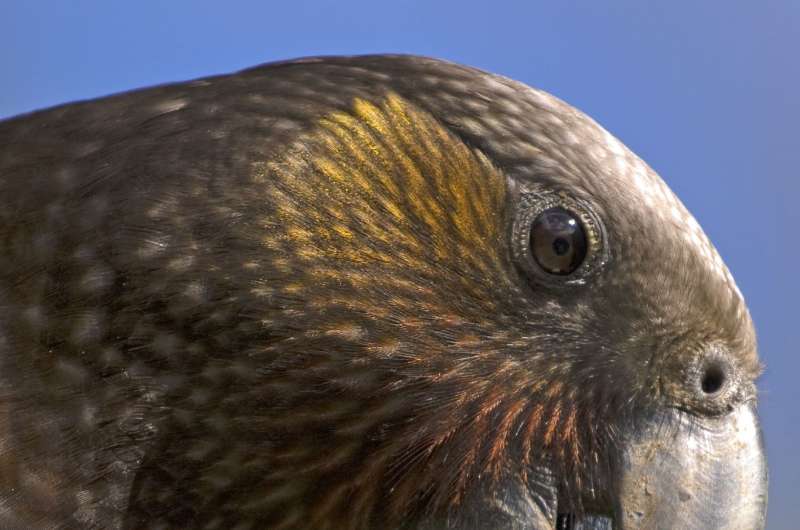The New Zealand kaka. Credit: Matt Binns/Wikipedia
(Phys.org)—A trio of researchers with Victoria University of Wellington in New Zealand has found that juvenile kaka (forest cousins of the well known kea mountain parrots) are better at solving problems than are older birds in the same area. In their paper published in Proceedings of the Royal Society B, Julia Loepelt, Rachael Shaw and Kevin Burns describe three types of experiments they conducted with wild kaka living in Zealandia Sanctuary, which is located on the North Island's Wellington peninsula, and what they learned by doing so.
As the planet changes due to global warming, biologists around the world have begun conducting various experiments to learn how plants and animals will adapt, or perish. In this new effort, the trio in New Zealand set about attempting to learn more about the ways kaka might adapt, by inducing wild specimens to engage in three types of experiments meant to gauge their adaptability levels.
The first test consisted of placing a block of wood under a treadle at a feeding station, which barred the birds from feeding unless they figured out that they had to move the block. The researchers found that none of the birds over three years of age were able to solve the problem, whereas approximately 40 percent of those under were able to do so.
The second experiment involved removing the treadle plate that normally served to raise the feeder lid when a bird stood on it. To get the food, the bird had to figure out that it needed to go around to the side and flip the lid manually. Half of the younger birds figured out the trick, while only one of the adults managed to do so.
In the third experiment, the researchers attached single cashew nuts to single lengths of string which they then tied to tree branches. To get the nuts, the bird had to reel them in using the string. All of the younger birds were able to master this trick, as did half of the adults.
The researchers suggest their experiments indicate that younger kÄkÄ are much more adaptable to changes in their environment and are thus more likely to survive changes. They also note that future generations might make out as well, however, as tricks that are learned when young, are typically carried on throughout the life of the bird.
More information: Julia Loepelt et al. Can you teach an old parrot new tricks? Cognitive development in wild kaka, Proceedings of the Royal Society B: Biological Sciences (2016). DOI: 10.1098/rspb.2015.3056
Abstract
Despite recent efforts to characterize innovative individuals within a species, we still know very little about the ontogeny of innovation ability. A number of studies have found that innovation rates are correlated with personality traits, such as neophilia and exploration. Juvenile birds are frequently more neophilic and explorative, yet few studies have found evidence of age-related differences in innovative problem-solving success. Here, we show consistently higher innovation efficiency in juveniles of a wild, omnivorous parrot species across a variety of tasks and contexts. We tested 104 kaka (Nestor meridionalis), ranging in age from four months to 13 years. Twenty-four individuals participated in all three of our problem-solving tasks, two of which involved a familiar feeder and one an entirely novel apparatus. Juveniles were the most efficient problem-solvers in all three tasks. By contrast, the adults' success was context dependent and limited to the novel apparatus, which did not require modification of a pre-learned behavioural response. This suggests greater behavioural flexibility in the juvenile birds, who also showed higher persistence and exploratory diversity than adults. These traits may enable young kaka to discover efficient foraging techniques, which are then maintained throughout adulthood.
Journal information: Proceedings of the Royal Society B
© 2016 Phys.org
























